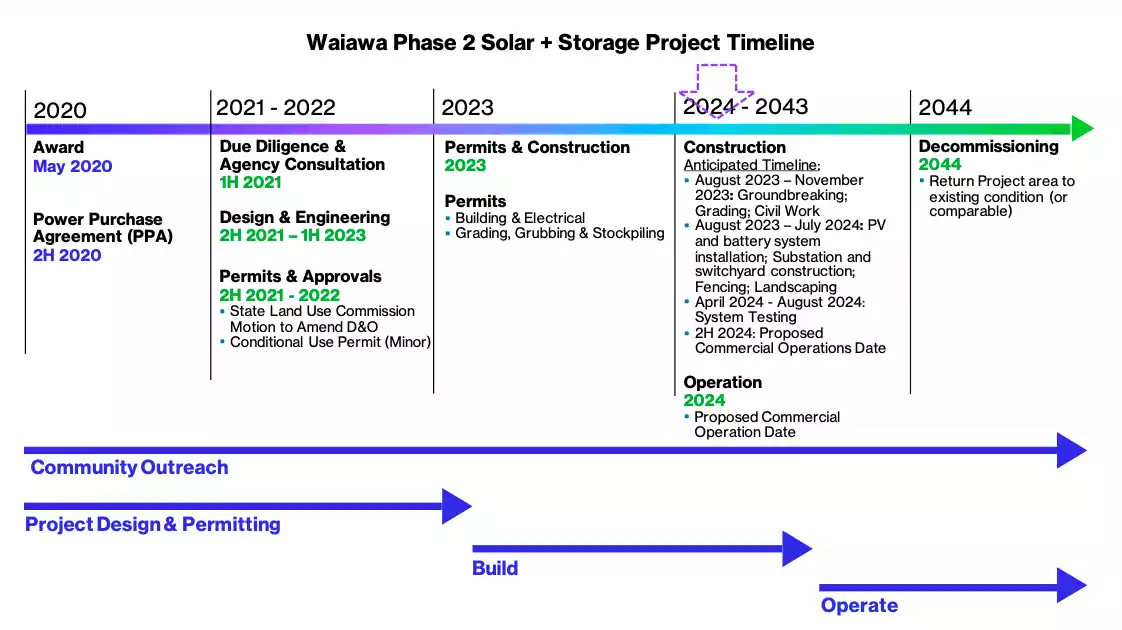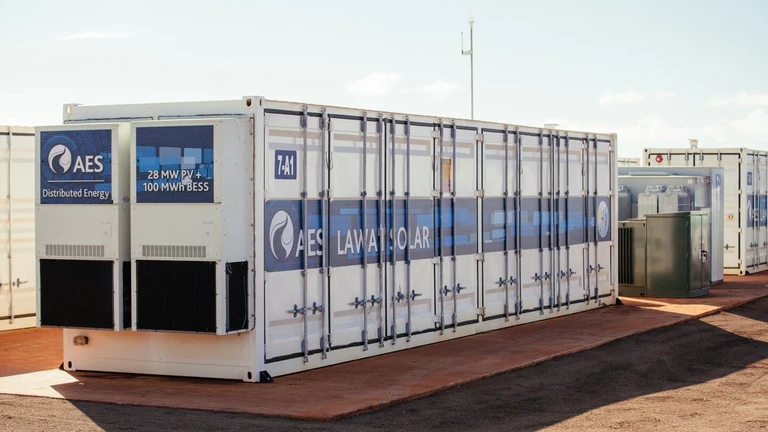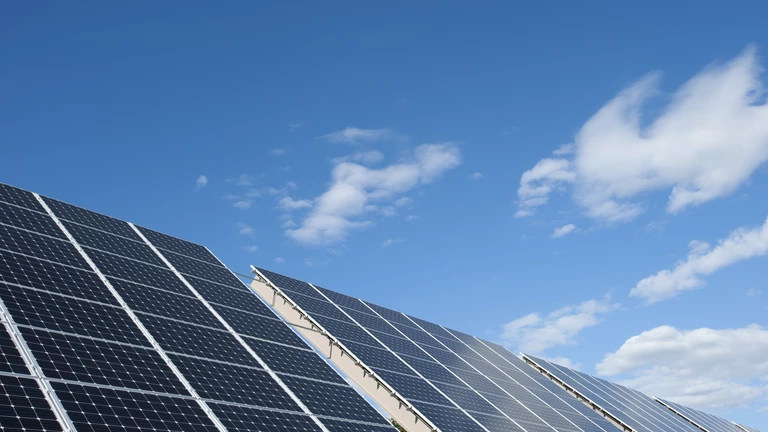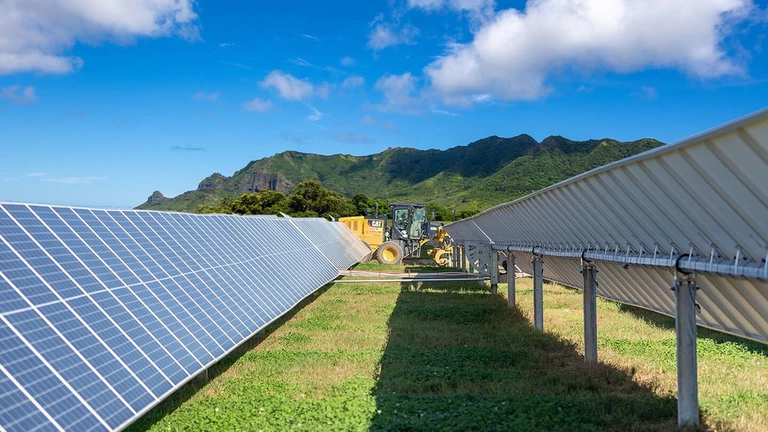Project contact information
If you have any questions or concerns, please contact our Community Outreach Representative.
Community Outreach Representative: Carrice Gardner
Email: waiawaphase2solar@aes.com
Project Hotline: +1 (808) 800-3942
Hawai'i’s 100% clean energy future – locally produced renewable energy
AES Hawaiʻi is proposing a 30MWac solar photo-voltaic array plus 240 MWh of containerized lithium-ion Battery Energy Storage System (BESS) on up to 387 acres of land in Waiawa - near the Ka Uka Boulevard exit of the H-2 freeway in central O‘ahu.
The Project will provide a clean, reliable source of power for approximately 18,000 O‘ahu homes and delivers power to Hawaiian Electric Company at a fixed price of $0.14/kWh over 20-years. The Project will enable Hawaiian Electric Company to burn less fossil fuel and is expected to contribute to the shutting down of existing fossil fuel plants.
The Project is anticipated to create approximately 565 local jobs during Project development and construction, and generate an economic output of approximately $131 Million.
We want to hear from you. Please provide your comments via our project email waiawaphase2solar@aes.com or sign up for our newsletter to get the latest project information.
*Formerly AES Distributed Energy (AES DE)

Community outreach
AES Hawai'i is deeply committed to being an active, invested member of the communities we serve.
As an initial step in the strategic community outreach process, the AES Hawai'i project team conducted a virtual public meeting to capture comments and feedback from the community. The meeting was held on July 8, 2020. A recording of the meeting can be found here.
We have received valuable feedback from community members and interested stakeholders during early-stage outreach. Comments, questions and feedback has directly contributed to the studies being conducted and project design. AES Hawai'i is in the process of evaluating the priority issues identified by the community and is committed to proactively addressing these as part of the Projects ongoing design efforts.
Community Outreach Plan:
General Strategy
- Identify and maintain a list of area leaders, interested stakeholders, and regional community organizations
- Provide Project information on an ongoing basis, including:
- Environmental benefits
- Economic benefits
- Job creation
- Gather Project feedback on an ongoing basis
Tactics
Specific methods to share information and collect feedback may include, but not limited to:
- Conducting Community Meeting(s);
- Issuance of Community Meeting Notices;
- Media outreach;
- Advertising;
- Outreach to area organizations, community leaders, and elected officials;
- Social media;
- Dedicated email address to gather input, comments, and questions;
- Project website; and
- Direct mail.
Local community support or opposition
AES Hawai'i will directly engage and listen carefully to community feedback regarding the Project. Through this process, project support and opposition will be identified.
Community outreach efforts
AES Hawai'i began the outreach process with preliminary engagement with key officials, community leaders, and interested stakeholder organizations
Community benefits
AES Hawai'i anticipates that initial community benefits from the Project will include delivery of clean, locally produced renewable energy as well as the generation of local jobs and economic activity. In addition, the Project will directly help the island achieve its goal of 100% renewable energy and offset reliance on price-volatile, imported fossil fuel.
As predevelopment of the Project proceeds, additional opportunities for benefits will be explored in direct collaboration with the area communities.
Contact Us
We want to hear from you. Please provide your comments or ask questions via our project email waiawaphase2solar@aes.com
Preliminary Project Schedule
AES Hawai'i is deeply committed to working with the community, area leaders, policymakers, and regulators to responsibly develop and operate all of its projects. To that end, our strategic approach is to engage early and often with stakeholders to share information about the project and most importantly, gather feedback to address issues that may arise. This sensitive approach is intended to enable timely approvals.

Environmental Compliance, Impacts and Permitting
Preliminary Site Assessment (including any pre-existing environmental conditions) and Studies
AES Hawai'i and its environmental consultant conducted a preliminary assessment of the environmental conditions at the site based on a review of publicly available maps, studies, and previous environmental reports prepared for the property. More detailed information is being obtained through due diligence and site-specific studies, as well as community feedback, and will be used to inform the design process.
The Project design will seek to avoid and minimize environmental impacts to the extent possible. Best Management Practices (BMPs) will be implemented to further minimize impacts throughout the Project lifecycle.
Feedback will be collected throughout the Project lifecycle, and updates will be provided as outlined in the Community Outreach section above.
Air quality
None of the equipment associated with the solar arrays or battery storage system emits air pollutants of any kind. Overall, the Project would provide a net benefit by replacing energy generated by burning fossil fuels with renewable energy, thereby reducing emissions of greenhouse gases.
Natural habitats and ecosystems, vegetation and wildlife
A biological survey was conducted to characterize the existing plant and animal habitat and determine whether species that are federally or state listed as threatened or endangered (pursuant to the federal Endangered Species Act or Hawaiʻi Revised Statutes [HRS] 195D) or are otherwise considered rare, have the potential to occur and could be impacted by construction or operation of the Project.
The results of the survey indicate that the Project area is comprised of former sugar cane fields that were heavily cultivated over a long period of time and are dominated by non-native species. Vegetation types in the Project area include Koa Haole Scrub, Non‐Native Grassland, and Mixed Non‐Native Forest. No federally or state-listed plant or animal species were documented within the Project area, although several could possibly occur within or traverse over the Project area.
The Project is being designed to minimize ground disturbance and maintain ample, natural, open space surrounding the Project facilities. Impacts to natural resources, including listed species that could possibly occur within or traverse over the Project area, would be avoided and minimized to the extent possible through the implementation of standard measures.
Climate
The Project would generate clean renewable energy which would replace the burning of fossil fuel for the production of electricity, thus offsetting greenhouse gas emissions and providing a beneficial impact on climate conditions. Hawaiian Electric has determined that the Project would displace approximately 2,908,097 barrels of fuel, and would decrease greenhouse gas emissions by approximately 1,078,948 metric tons over its lifetime.
Flood and tsunami hazards
The project is not within the FEMA 100-year flood plain or the tsunami evacuation zone.
Noise
Once operational, the Project is anticipated to generate minimal noise.
Roadways and traffic
A traffic impact analysis report (TIAR) will be conducted and any required mitigation will be implemented during the construction phase of the project. Once operational and for the duration of the project, it is anticipated there will be minimal new traffic generation.
Visual resources
A visual impact analysis that identifies a zone of visual influence has been conducted, and visual simulations are being developed to assist with refinement of the location of Project components in order to minimize the impact to neighboring residents and commuters to the extent practicable. As AES progresses with the Project’s design & engineering efforts, visual simulations will be updated to reflect refinements to the Project design.
Solid waste
The facility is not anticipated to generate solid waste. The Project will be decommissioned at the end of its lifecycle and the Project area will be returned to its existing condition (or comparable). A decommissioning plan will be developed to ensure Project components are recycled in accordance with standards and regulations applicable at the time of decommissioning.
Water features
A delineation was conducted within the Project area to identify any water features, such as wetlands or streams, that may be considered Waters of the U.S. and therefore subject to regulation by the U.S. Army Corps of Engineers (USACE) under Section 404 of the Clean Water Act.
Fieldwork for wetland delineation has been completed, and the delineation report will be compiled and submitted to the USACE for their jurisdictional determination. The Project will be designed to avoid any jurisdictional Waters of the U.S. to the extent possible.
Cultural, archaeological, and historic studies
AES Hawai'i is deeply committed to responsibly developing its Projects. In keeping with this principle, we have prioritized efforts to study the cultural, archaeological, and historic features of the proposed project site.
A Cultural Impact Assessment (CIA), Archaeological Inventory Survey (AIS), and an archeological site preservation plan have previously been performed for this site. The AIS was accepted by SHPD in April 2015.
Existing studies are being updated and SHPD will be consulted as appropriate.
City Zoning and Land Use Classification
State of Hawai‘i Land Use District: Urban
The proposed solar facility is consistent with these state and county land-use regulations. No changes in the land use classification or zoning district would be required for Project implementation.
City & County of Honolulu Zoning:
-
Low-density apartment (A-1)
-
Community business (B-2)
-
Residential (R-5)
-
Industrial commercial mixed-use (IMX-1) zoning districts
Discretionary and non-discretionary land use, environmental and construction permits and approvals
Based on a preliminary review, the following determinations have been made:
U.S. Federal
- Federal permits or approvals are not anticipated for project implementation
- Compliance with the National Environmental Policy Act (NEPA) is not anticipated
City and County of Honolulu
- a Conditional Use Permit (minor) is anticipated
- a Zoning Waiver may be required
- Additional building permits are anticipated, including:
- Electrical permits
- Grading/grubbing/stockpiling permits
State of Hawai‘i
- An Environmental Assessment (EA) or Environmental Impact Statement (EIS) are not anticipated – the project does not “trigger” HRS Chapter 343.
- State Land Use Commission approval may be required to ensure the proposed project is consistent with the master plan and Decision and Order for a previous reclassification of the property to Urban.
- Certain construction-related State permits may be required, including:
- a National Pollutant Discharge Elimination System (NPDES) permit
- a Noise Permit
- Compliance and coordination with the State Historic Preservation Division under HRS Chapter 6E is anticipated
Listing of anticipated Permits and approvals
|
Permit Name |
Authority Having Jurisdiction |
|---|---|
|
HRS Chapter 6E Compliance (Historic Preservation Review) |
SHPD |
|
National Pollutant Discharge Elimination System (NPDES) |
DOH - Clean Water Branch |
|
Noise Permit |
State Department of Health (DOH) - Indoor and Radiological Health Branch |
|
Conditional Use Permit (minor) and Zoning Waiver (if Needed) |
DPP |
|
Building Permit & Electrical |
DPP |
|
Grading & Grubbing & Stockpiling Permit |
DPP |






